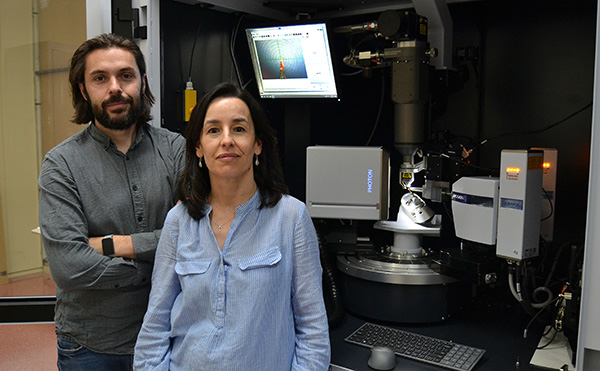The ICMM-CSIC gets an X-ray diffractometer with three ultra-high brightness sources, unique in Spain
The device, part of the diffraction service, allows working with copper, molybdenum and silver wavelengths.

The X-ray diffraction service of the Madrid Institute of Materials Science (ICMM), CSIC, has just incorporated a unique machine in Spain into its equipment: an X-ray diffractometer with three ultra-high brightness sources. The service, which has Felipe Gándara as the scientific manager and Fátima Esteban as the technical manager, offers new possibilities thanks to its state-of-the-art technology.
Diffractometers are instruments used to measure the diffraction of a radiation beam (in this case, X-rays) on a sample of a material. With its results, it is possible to know the internal structure of the material being measured, something fundamental for the design of new materials with à la carte properties.
What makes this new piece of equipment at ICMM special is "the considerable increase we have in X-ray intensity," says Gándara. The researcher explains that these X-ray sources (or micro sources) allow more current to be emitted to achieve more excellent brightness (photons per second) to illuminate the samples to be measured. "The peculiarity is that in the same equipment, you have three sources with three different wavelengths and that, in addition, all three are very high brightness, being also air-cooled micro-sources, which require practically no maintenance," he stresses.
This diffractometer, which allows working with copper, molybdenum, and silver wavelengths, makes it possible to carry out different studies on different types of samples. "The detector is also highly sensitive, and allows very fast measurements to be made because diffraction images are collected without response dead time," Gándara also points out. In addition to all this, this new device allows measurements to be made at low temperatures, up to 30 degrees Kelvin (-243.15ºC).
“It is a device that is designed to make single-crystal measurements”, continues Gándara, who points out that thanks to the advances in this machine, it will be possible to determine, with greater speed and precision, the structure of the different types of compounds: “Crystalline materials in general but of a different nature, from oxides, metal-organic compounds, purely organic compounds, even macromolecules, their structure can be resolved with this single-crystal X-ray diffraction technique”.
Not only that, but the new apparatus is demonstrating great versatility and is making it possible to make crystalline powder diffraction samples. "From there we can also take advantage of having a source with a silver wavelength, which allows studies to be carried out with high resolution," the scientist details.
“We can also study interactions within the pores of these materials”, adds the researcher: “We work with porous materials, where gas molecules or catalytic substrates diffuse inside the nanopores of our materials and interact with the atoms of the network formed; With this equipment, we will also be able to characterize at the atomic level what are the interactions between the substrates and between the atoms of the network or between various molecules that may be crossing the holes in the material”. The latest innovation in this device will be added throughout the year: a high-pressure chamber to take measurements and study changes in the crystalline structure of a material at different pressures.
This equipment has been acquired through the EQC2021-006822-P grant funded by the Ministry of Science and Innovation, State Research Agency, and by the European Union, Next GenerationEU, Recovery, Transformation and Resilience Plan.
X-Ray Diffraction Service
This equipment joins the ICMM X-ray diffraction service, open to the entire scientific community of the country and which has a total of six devices, computer equipment, specific software, and access databases for those who request the use of the devices. “It is not usual for a research center to have so many diffraction equipments available”, defends Esteban.
Of these six pieces of equipment, three are for X-ray powder diffraction with copper wavelength sources. They are intended for measurements of polycrystalline samples for phase identification or for quantitative and qualitative analysis of sample composition. This equipment also has position-sensitive detectors, which make the measurements faster.
In one of them, addition, this month an improvement has been carried out by incorporating a motorized XY table and a set of collimators to perform microdiffraction, which allows diffraction measurements to be made in different areas in the same sample (a thin film, a chip, minerals, etc.).
Access to the service also allows the use of computer equipment with specific software for data processing, structural modeling, etc. These include EVA (for data analysis), TOPAS (for quantitative analysis and powder structural resolution), and LEPTOS (for analysis of thin layers).
An important point is that some of the devices are 'self-service': users, after receiving specific training, can make their own measurements of their samples. “That is also very versatile because the samples of each user are different and have their peculiarities”, both explain.
-- Ángela R. Bonachera (text) and Carlos Arroyo/Morgan (photo) - Communication and Outreach Unit - ICMM --
Instituto de Ciencia de Materiales de Madrid (ICMM)
Sor Juana Ines de la Cruz, 3
Cantoblanco, 28049
Madrid, España
Telephone: (+34) 91 334 90 00
Email: @email
Communication Office: @email

Acknowledge the Severo Ochoa Centres of Excellence program through Grant CEX2024-001445-S/ financiado por MICIU/AEI / 10.13039/501100011033

Contacto | Accesibilidad | Aviso legal | Política de Cookies | Protección de datos